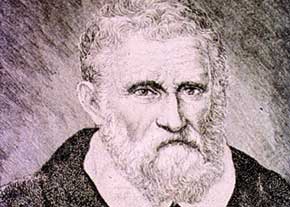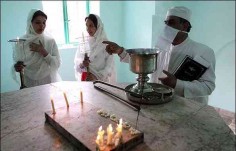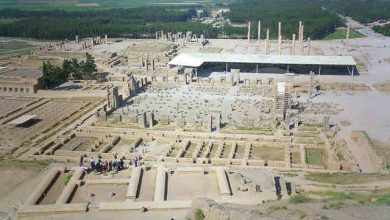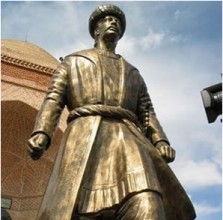Iran in travelogue (Marco Polo)
Travelogues are valuable sources for historical studies. These works have recorded the details of customs, habits and social life of the past tribes. "Pythagorean travelogue in Iran" attributed to Pythagoras, the outstanding scientist of ancient Greece, "Al-Masalek wa Al-Mamalek" by Ibn Khardadabeh, "Ibn Fazlan's travelogue", "Travelogue of Abu Dolf", "Ibn Hoqal's travelogue", "Ibn Batuta's travelogue", "Clavijo's travelogue" and "Marcopolo's travelogue" are among the travelogues that were written before the Safavid era and contain information about Iran.
Marco Polo in the year 652 He was born in Venice, Italy in 1254. His father, Niccolò Polo, was an active merchant who traded with Constantinople. In the year 1260 Milady Niccolo and his brother Maffeo went east……
Continue and download the pdf file of all this material in the rest of the article
from the main lands of producers of goods such as silk, spices, precious stones, ivory, fine skins and jewelry and… to visit. their journey 9 The year lasted and they reached the service of Qobil Qaan, the Mongol ruler of China. They in the year 1271 They left for China again from Venice. This time young Marco was with them. recent trip 24 It took years 17 They spent that year with respect and credit with the Khaqan of China and finally in the year 1295 They returned to Venice. Marco that now 41 He was imprisoned following the conflicts between Venice and Genoa. In prison, with the help of his notes and archives, he narrated his travel memories to his fellow inmates and left his travelogue as a memory..
Marco Polo's descriptions of his travels inspired other European explorers and traders to expand their geographical knowledge and step into a world beyond the past.. Christopher Columbus, inspired by Marco's writings, thought that it was possible to reach the East by sailing westward.. When he in the year 1492 His arrival in North America brought with him letters from the King of Spain that were written to the ruler of China. He also had a copy of Marco Polo's book with him, which had many margins written on it.
Marco in Iran: Marco traveled to Iran in the 7th/13th century. Tabriz was the first big city of Iran that Marco entered. He calls it by the name "Tauriz".. The city of Tabriz during the time of Abaqa Khan (680 ـ 663) That is, a few years before Marco Polo arrived there, it was the main seat of the patriarchs. At this time, with the fall of Baghdad and the decline of its prosperity, Tabriz had become more important. Especially since the trade road from India to Constantinople passed through this city in those days.
He says: "Tabriz has such a good location that commercial goods from India, Baghdad, Mosul, Hormuz and other places can easily enter the city.… People make a living by trading and crafting, and crafting is weaving different types of cloth, precious cloths are woven from gold and silk.. "Precious stones and pearls are also bought and sold here, and trade in the city is very good, and the traveling merchants make great profits." As it can be seen, the economic and commercial components constitute Marco's descriptions. Apparently, many Europeans lived in Tabriz during Marco's time. He says: "Many Latin-speaking businessmen come to Tabriz". Another point is the existence of "Armenians, Nestorians, Jacobites and Georgians" in Tabriz.. This accuracy of Marko is remarkable for Europeans who have known only the Roman Church for a long time. He also has harsh judgments about Muslims and says: "According to the law brought by the Prophet, mistreating non-Muslims and taking their property is not considered a sin.".
He is on his way back in the year 1294 He came to Tabriz again. At this time, he mentions the existence of a monastery: "Near Tabriz, there is a pious monastery called Holy Barsamuy. A great monk in the guise of Carmelites lives in this monastery with many monks. They are always busy weaving woolen belts to avoid unemployment and laziness… Because these belts relieve body pain, everyone is eager to get them."
Marko mentions Saveh after Tabriz. Through Hamdaleh Mostofi, we know that Saveh at that time from 46 Diyeh was formed and it was a prosperous city. Saveh is the same city where, according to the sayings, the Three Maghs were among the first to announce the birth of Jesus and rushed to Jerusalem to meet him.. Marco was curiously looking for a sign from them. He asked the people about the life of these three magicians, but no one knew anything about it. In this regard, he mentions a castle that was known as the fire worshipers' castle.
This tourist of Iran is composed of 8 The state knows: 1- Qazvin 2- Kurdistan 3- Lorestan 4- Shulestan 5 Isfahan 6 - Shiraz 7 Shabankare 8 Tun and Qain; This division does not correspond exactly with the geographical-political position of Iran during the time of Ilkhans. Of course, Iran was not a unified political unit at that time and some regions had independent governments, but from comparison with works such as Al-Beldan Abul-Fada's calendar, the importance of other regions such as Khuzestan, Gilan, Kerman and… We will guide you. One of Marco's bitter experiences was dealing with bandits. It seems that banditry was common in sparsely populated and desert areas.
After this, Marco talks about the city of Yazd. According to him, silk fabrics known as "Yazdi" were very famous among merchants and were exported to all over the world.. He says: “From the city, if you will (Towards Kerman) You have to get out 8 day pass through a desert where only 3 "There is a place for passengers." The existence of many groves and game such as quail, partridge and zebra in these areas has been interesting to him.. After Yazd, he reaches Kerman. In his opinion, the people of Kerman are good and calm.
He considers Kerman to be the center of precious stones and industrial stones such as iron. In addition, the performance of Kermani women in the production of handicrafts is not far behind in Marco's opinion. "Women and girls make beautiful embroideries of silk and gold with different colors and patterns with needles and use them to decorate curtains, quilts, and rich pillows." He also mentions the numerous hot springs in this area that cure skin diseases.
He also says that the best game and the most important birds in the world can be found in the mountains of this land. He was careful about Kerman because 3 Bar passed through this city. Kerman enjoyed relative prosperity at that time and had strategic importance. After the Ilkhans, this city hosted Dutch and English East India companies during the Timurid and Safavid periods..
After Kerman, he mentions a big city named "Komedi".. The ruins of this city were identified in the new period in the north of Jiroft. Apparently, this city lost its prosperity after repeated attacks by the Mongols. Hormuz Plain is also mentioned in Marco's travelogue. This area was the trading place of Persian Gulf merchants. Marco mentions its prosperity in connection with Indian traders and mentions large ships loaded with spices, pearls, cloth, precious stones and other goods..
His description of Hormuz is one of the most important parts about Iran. He says: «shipsThe one that is built in Hormuz is very dangerous for navigation and the people who travel with it are always in danger.. The reason for this is that the builders do not use any nails in the construction of ships, because the wood used to build ships is so hard that if they try to drive a nail into it, it breaks apart like pottery, and the nail itself sometimes breaks or bends. Therefore, the two ends of the timber are carefully drilled, then strong wooden nails are inserted into those holes and the heads of the nails are tied together with strong ropes.. To protect the bottom of the ships, they don't use bitumen or tar, but grease it with a type of fish oil, then fill the seams with hemp or flax or hemp pulp.. Ships have only one mast, one rudder and one deck.
Their anchors are not iron, so in stormy weather, the ships are pushed to the shore and are crushed by hitting the coastal rocks.. The residents of this place are Muslim and Siye Chardeh… With dates mixed with other ingredients, they make a good type of wine.
Those who are not used to drinking alcohol, if they drink a little of it, they immediately get diarrhea, but after recovery, it adapts to their mood and makes them fat. The food of the native people here is different from our food.. They do not deal with wheat bread and meat, and most of their food consists of dates and salted fish… For certain people who die, it is customary that the period 4 They mourn over him every day of the week. There are some people whose profession is singing and crying. In return for a certain wage, they come and mourn over the heads of the dead and start crying and screaming" he also refers to the hot and sometimes deadly monsoon winds of this region..
Marcopolo's report on the status of Ismailia in Iran, right or wrong, is an interesting document about this sect. This report is at least the result of conversations that existed in the circles of that time. He addressed Hassan Sabah as the old man of the mountain and called him Aladdin. Marco says: "He had created a luxurious garden in the middle of the beautiful valley, where there were all kinds of trees with delicious fruits and fragrant flowers.. There were also small and large palaces in different parts of the garden, all of which were decorated with beautiful paintings and silk curtains and rare handicrafts.. Through the narrow streams that were dug in these buildings, clear water, milk, wine, and honey flowed in all directions, and the inhabitants of these huts were beautiful and fit girls who had nothing to do but sing, dance, and play music.. Here he had a large number of powerful slaves who followed Pir Kouhistan just as Muslims follow their Prophet. They had an important mission in the guise of Hashashion.
They were first passed out in groups with opium, and then they went to the so-called paradise. When the old man of the mountain needed one of his slaves to destroy someone, he would order him to be taken out of paradise again with the help of opium.. Returning to the garden depended on following orders, and the innocent man would do anything to achieve his goal. In the year 1262 Miladi Halakukhan decided to end the life of Pirkohestan and his sect. A large army 3 He had besieged his palace for the whole year and finally succeeded in conquering it. Pirkohestan and his companions were killed and Saharangiz palace and garden were razed to the ground.
Of course, his travelogue also has a pathological aspect, Marco, who was born after the Crusades, was influenced by Western assumptions about Islam and the Prophet.(ص) Was. In some cases, he has attributed immoralities such as theft that he observed in Islamic lands to the Muhammadan religion.. He did not have a precise understanding of the views of Muslims and the existing sects, for example, he called the Ismaili religion of Alamut as Muhammadan, thus it is assumed that there is a connection between the violence of Hassan Sabah's followers and the Muhammadan religion.. His Christian tendencies are also evident in his work. For example, in connection with the fall of the caliphate of Al-Abbas and the surrender of Caliph al-Mustasim, the caliph says after seeing the miracles and dignity of the Christian shoemaker. (Moving the mountain) At heart, he became a Christian and used to hang a cross under his clothes, after his death, they found this cross on his neck.
Jamal Razmjoo
References:
Travelogue of Marco Polo translated: Habibalah Sahihim Marcopolo in Iran: Alphonse Gabriel, trans: Parviz Rajabisfari Marcopolo: Mary Hall, trans: Farid Javaherkalam's travelogue of Marco Polo: Sayah Javadan and the Court of the Mughal Dynasty, Abdul Mohammad Aiti, Information and Library Magazine, Bahar 1352.
Source:jam jam– The painter of the days
Click on the link below to download this entire article in PDF file







